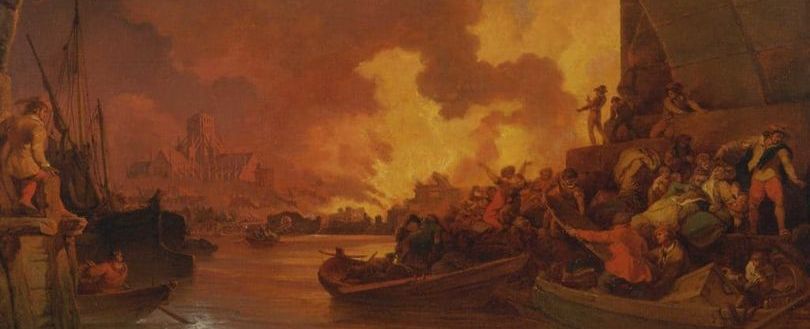- Homepage
- News
- Blogs & Articles
- On this day, forgotten disasters: The ratcliffe fire

On this day, forgotten disasters: The ratcliffe fire
Like it? Share it!
21 July 2023 by Kirsty Lavell, Marketing Manager
As fire professionals in the UK, it is crucial to examine this historic event and extract valuable insights that can inform our practices, enhance fire safety measures, and contribute to the goals of the Fire Industry Association. Join us as we delve into the details of the Ratcliffe Fire, its aftermath, and the invaluable lessons it holds for fire professionals operating in the UK.
Located in the riverside districts of East London, Ratcliffe was a hub of industrial buildings and warehouses in the late 18th century. On an uneventful afternoon, at approximately 3 pm on July 23rd, 1794, disaster struck when an unattended kettle of pitch boiled over at Clovers Barge Yard on Cock Hill. This innocuous incident ignited a catastrophic chain of events that resulted in the largest fire London had witnessed between the Great Fire of 1666 and the Blitz of 1940.
With alarming speed, the flames from the ignited pitch rapidly spread to a nearby barge loaded with saltpetre, a key component in gunpowder and matches. The subsequent explosion unleashed a violent force, hurling burning fragments in all directions and igniting a fierce conflagration. The fire quickly engulfed adjacent areas, including timber yards, rope yards, and sugar warehouses, exacerbated by narrow streets and low tide, which hindered the firefighting efforts.
Tragically, the Ratcliffe Fire razed a staggering 453 houses to the ground, displacing approximately 1,400 individuals and leaving them homeless. In response to this catastrophic event, the government and several prominent entities stepped forward to support the affected community. Temporary shelters were erected near St. Dunstan's Church, offering refuge to those displaced by the fire. The Corporation of London, Lloyds, and the East India Company contributed £2,000 in relief efforts, emphasizing the importance of collective support and collaboration during times of crisis.
While the Ratcliffe Fire left an indelible mark of destruction, it is remarkable that a lone building, No. 2 Butcher's Row, defied the flames and emerged as the sole survivor. This resilient structure serves as a poignant symbol of endurance and reminds us of the imperative to fortify buildings against fire hazards. Fire professionals can draw inspiration from this survivor, reiterating the significance of robust fire safety measures and practices in protecting lives and properties.
The Ratcliffe Fire of 1794 carries profound lessons that resonate with the objectives of the Fire Industry Association and fire professionals in the UK. By examining the challenges faced by firefighters during this historic event, we can distil essential insights that enhance our understanding of fire safety.
These lessons underscore the importance of:
Effective Fire Prevention Strategies: The Ratcliffe Fire highlights the critical need for proactive fire prevention measures to mitigate the risk of devastating incidents. Fire professionals must prioritize fire safety assessments, identify potential hazards, and implement preventive measures in industrial settings and warehouses.
Early Detection Systems: The rapid spread of the Ratcliffe Fire underscores the urgency of early fire detection systems. Investing in innovative technology such as advanced smoke alarms, heat detectors, and fire suppression systems is vital to minimize response times and prevent fire escalation.
Robust Emergency Response Protocols: The challenges faced by firefighters in battling the Ratcliffe Fire emphasize the importance of robust emergency response protocols. Fire professionals must engage in rigorous training, maintain effective communication systems, and collaborate closely with other emergency response agencies to ensure swift and coordinated actions during fire incidents.
History has shown that catastrophic events often spur advancements in fire safety regulations and practices. Just as the Ratcliffe Fire compelled the government and corporations of the time to take decisive action, recent incidents like the Grenfell Tower tragedy have reaffirmed the urgency of continuous improvement in fire safety standards. The Fire Industry Association remains steadfast in its commitment to working alongside regulatory bodies, third-party certification organizations, and electrical contractors to enforce and enhance fire safety regulations in the UK. Through collective efforts, we strive to create safer communities, prevent devastating fires, and protect lives and properties.
The Ratcliffe Fire of 1794 stands as a sombre reminder of the destructive power of fires and the need for unwavering dedication to fire safety. Fire professionals in the UK must embrace the lessons learned from this historic event, integrating them into their daily practices. By prioritizing effective fire prevention strategies, implementing early detection systems, and refining emergency response protocols, we can collectively build a future where devastating fires are minimized, and communities are resilient in the face of adversity. The Fire Industry Association remains resolute in its mission to promote fire safety, foster innovation, and empower fire professionals to protect lives and properties across the UK.
-
Kirsty Lavell
Marketing Manager
Related posts
-
Navigating Gateway 2 & 3: Supporting Fire Safety Professionals
17 September 2025
By FIA Team, FIA Team
Related news
-
New FIA Guidance on BS 5839-1 Fire Alarm Categories
23 December 2025
-
Launching our Practical Training and Assessment Course
09 December 2025
